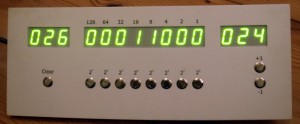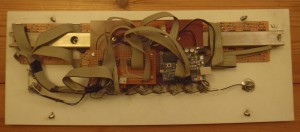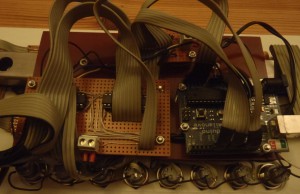My first larger project using the Arduino platform is an exhibit for the German Museum of Technology in Berlin. It will be shown in the Konrad Zuse exhibition. 
The device shows a random number (left display). By activating the correct bits in a binary representation (center display) the visitor has to assemble this number (right display). From a programmers point of view this is really not a big deal, but for most people this can be a challenge.
This device was created in cooperation with Felix Scharstein who has a long experience in objects and machines for museums. An article on a more mechanical device for the same exhibition will follow soon.
Technical Facts
The device is controlled by an Arduino Duemilanove. All buttons are connected to digital inputs: eight buttons for the digits, two buttons to increase (+1) or decrease (-1) the number and one button to request a new random number. The front panel was made from white Corian.
 The displays consist of 14 single 7-Seg-modules (Kingbright SA10-21GWA) connected to two MAX7221 controllers. One controller drives the center display, the other drives the left and right display. The controllers are cascaded and connected to the Arduino using a serial interface (3 pins). The Arduino library LedControl is used to control the displays from the software. By using this excellent library the main program can be kept really small and simple (~150 lines). The program logic is trivial, no special programming skills were required.
The displays consist of 14 single 7-Seg-modules (Kingbright SA10-21GWA) connected to two MAX7221 controllers. One controller drives the center display, the other drives the left and right display. The controllers are cascaded and connected to the Arduino using a serial interface (3 pins). The Arduino library LedControl is used to control the displays from the software. By using this excellent library the main program can be kept really small and simple (~150 lines). The program logic is trivial, no special programming skills were required.
 All wiring was done by hand (~800 soldered joints). This was a hard job, but finally everything is working. The device will be installed in the museum in the next weeks.
All wiring was done by hand (~800 soldered joints). This was a hard job, but finally everything is working. The device will be installed in the museum in the next weeks.
Many thanks to the creators and contributors of Arduino and LedControl!

















